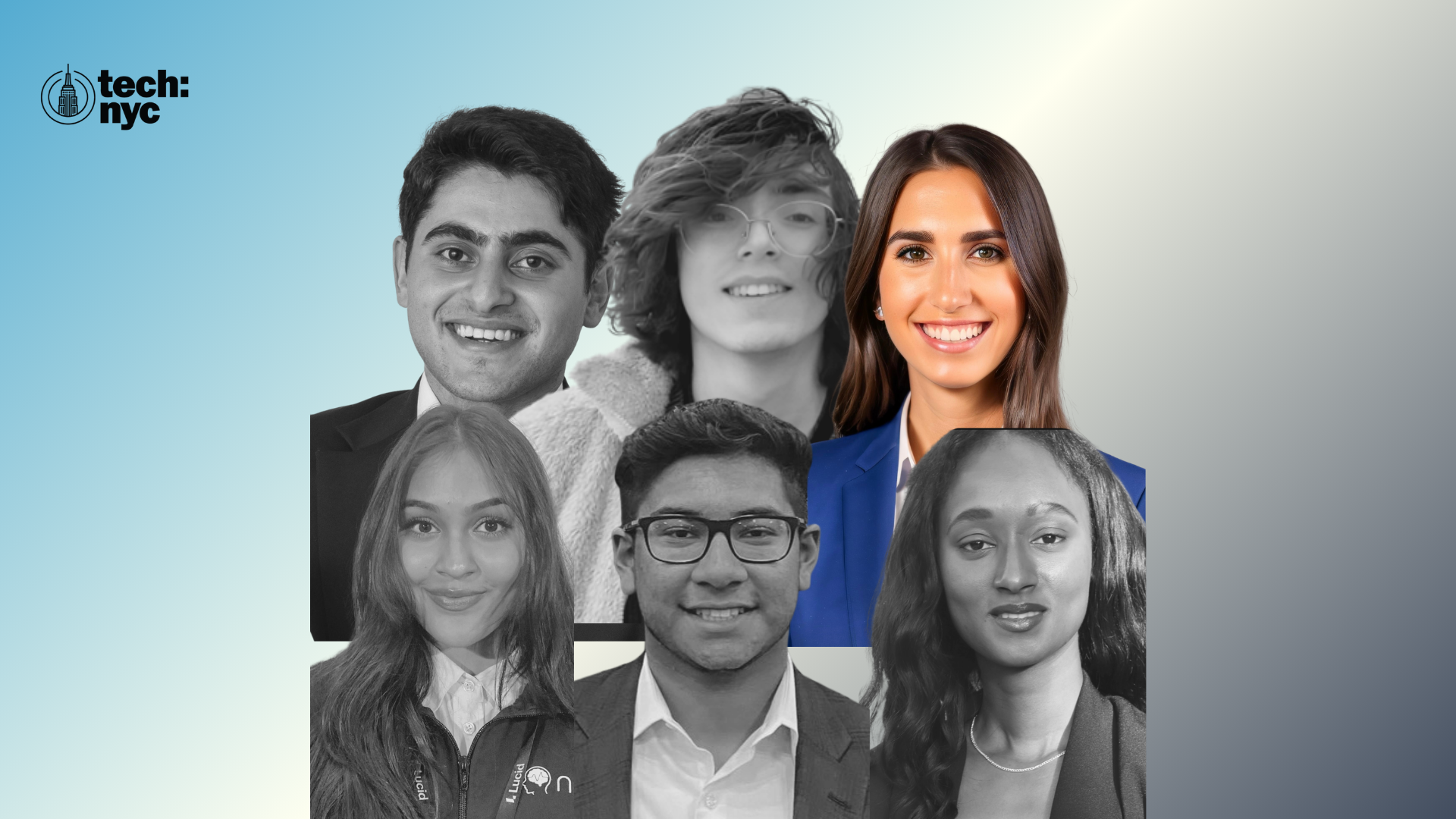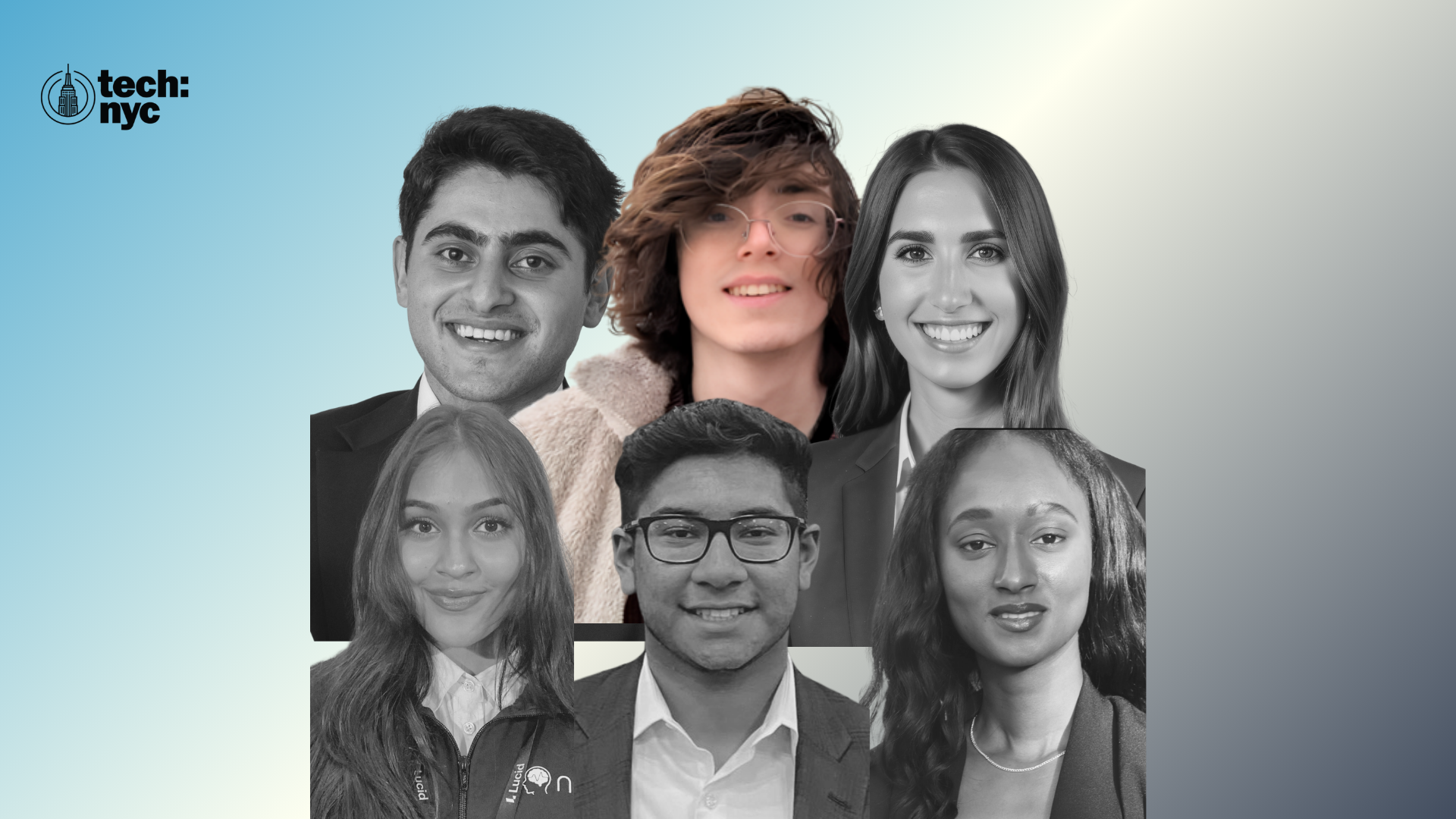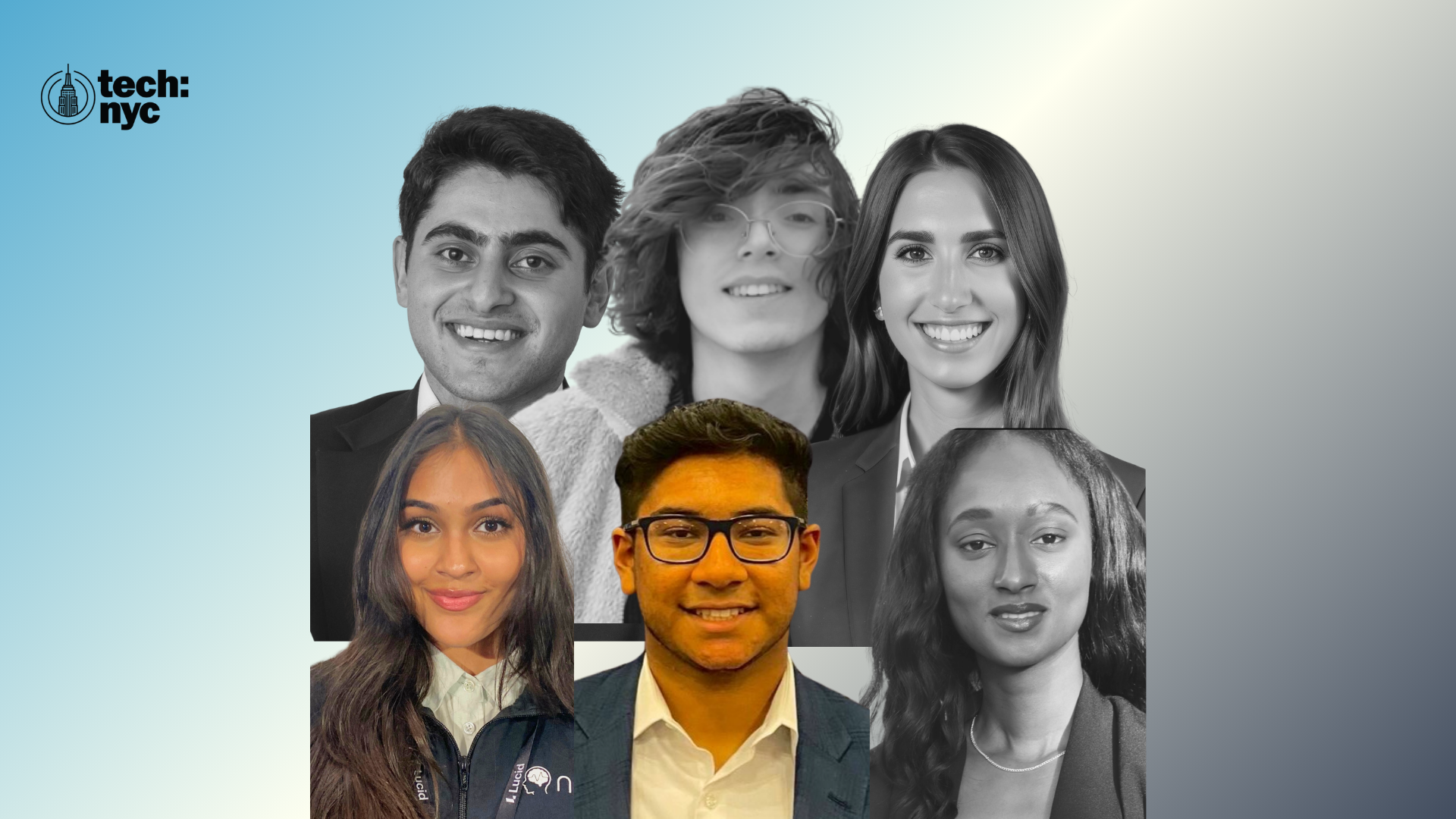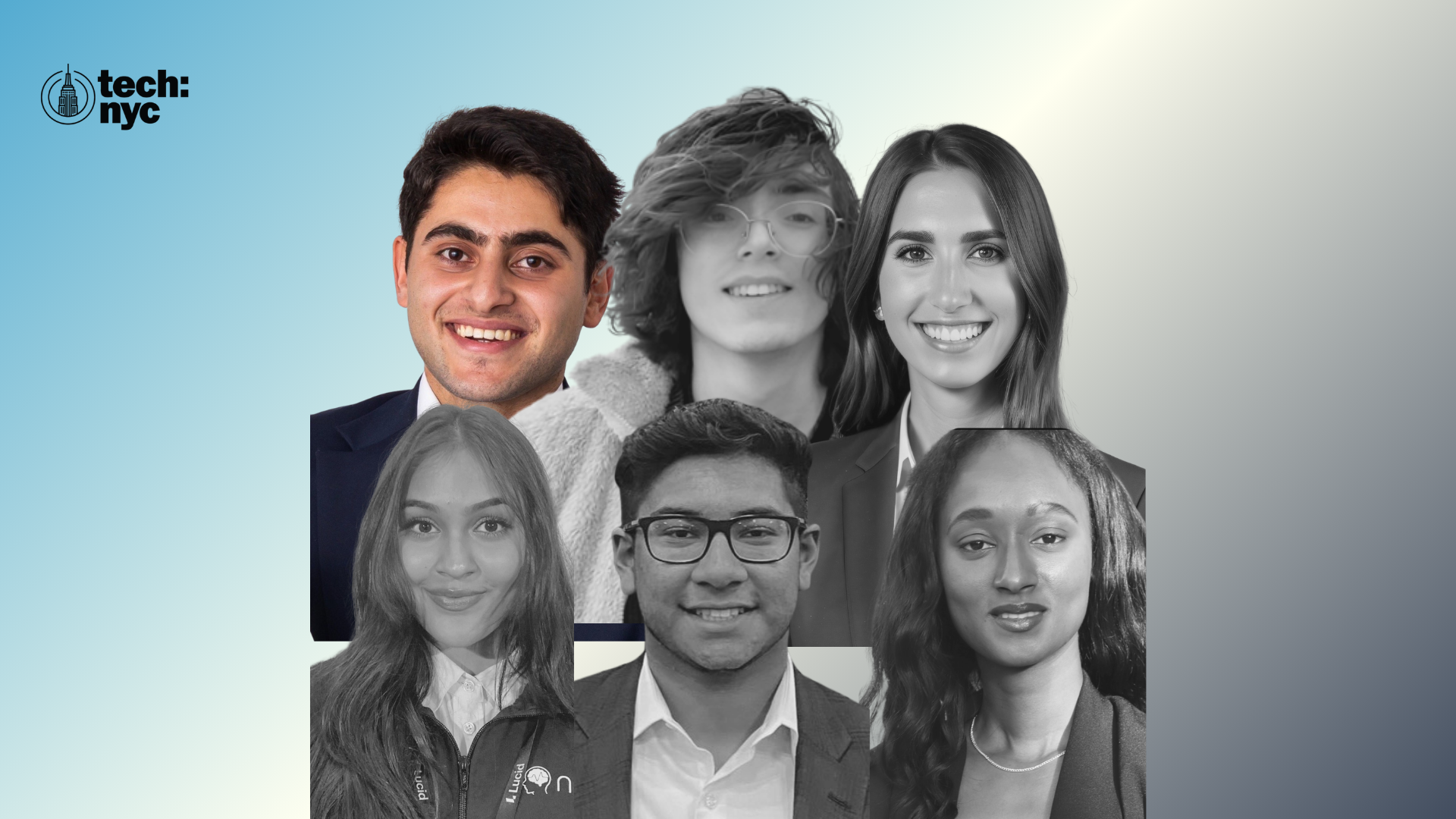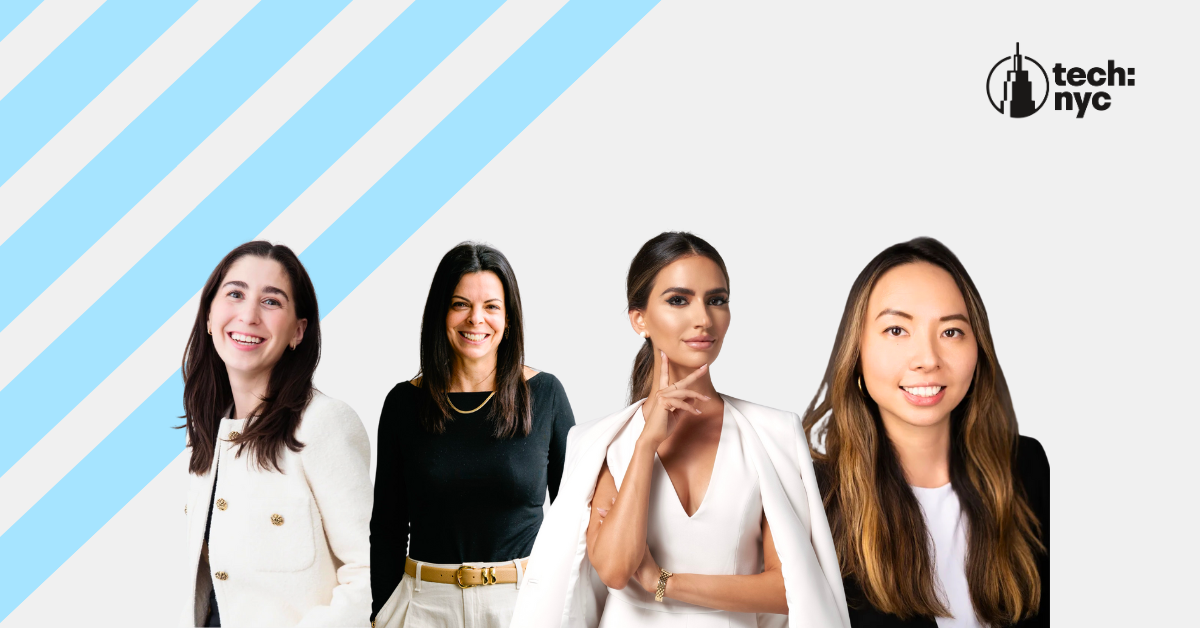Companies to Watch: From Campus to Capital, New York Student Startups You Need to Know
The NYC student tech pipeline is thriving:
NYC’s universities, including Columbia, Cornell Tech, CUNY, and NYU, graduated over 87,000 AI-relevant degree holders from 2018 to 2023.
As of 2021, nearly 500 startups were formed in NYC just by university researchers or alumni.
NYC retains 66% of its graduates, a higher rate than both the Bay Area and Boston.
From 2021-2024, about 490,000 recent college graduates moved to NYC, making it the top destination for new grads.
Plus, Tech:NYC and Accenture’s report on Generative AI in NYC found that nearly 90% of local tech company execs are confident in their abilities to secure AI skills from the city’s talent pool.
It’s clear that New York’s universities are setting students up to be successful technologists and founders.
As graduation season hits full swing, we’re excited to spotlight six New York student founders from five startups who are successfully running companies all while managing to balance the full-time job of being a student.
For this edition of Companies to Watch, meet:
NYU Stern’s Julia Kingsley (founder of Context Data)
Cornell Tech’s Ryan Hardesty Lewis (founder of Polyrook)
Baruch College’s Souadou Bah (founder of PulseBridge)
New York Institute of Technology’s Pari Patel & Ryan Ahmed (cofounders of Niura)
NYU Tandon’s Asser El Ashwah (founder of Vitalis)
Context Data
Julia Kingsley
“[New York City’s] ambition, urgency, and energy push you to move faster and think bigger.”
What does your company do? What problem is it working to solve?
Context Data helps SMBs and lean teams turn internal data, documents, and systems into secure, custom AI tools, like internal apps and customer chatbots, without any engineering resources. With employees pasting sensitive data into public AI tools, we solve the security risk by delivering private, behind-the-firewall AI applications and agents built on SOC 2-certified infrastructure. Companies unlock insights, faster decision making and productivity without compromising privacy.
A question we like to ask every founder – why New York?
I’ve lived here nearly a decade — it’s New York or nowhere. New York is also one of the best places to launch a platform like ours given our core financial services, research and online retail focus; so many of our potential customers are here. Plus, the ambition, urgency, and energy push you to move faster and think bigger.
As a student founder, how have you gone about building your team and establishing a startup culture while balancing academics?
It’s not easy — I’m working harder than I did in private equity, but it’s 10x more fun. We’ve built a team with complementary strengths and trust. Stern’s network and resources have been game-changing for finding talent, customers, and staying focused on what matters.
You’re dealing with data from personal places — emails, company docs, etc. How do you make sure people feel safe connecting that data to your platform?
We lead with privacy — it’s our top priority and biggest differentiator. Each customer deployment is isolated and built on SOC 2-certified infrastructure. We never train on client data, and customers retain full ownership and control.
As a founder, what are your self-care routines to recharge while still being heads down building a company?
My self-care is a good sweat. I hit AARMY for workouts and go to Othership for sauna and cold plunge resets. Just as important, I carve out time to be fully present with my classmates, friends, and family. It’s the only way to stay grounded while building something this intense.
What’s next on the roadmap that you’re excited about?
We’re launching a white-label platform that lets companies fully own and deploy their AI agents internally along with a lite open source version. It means tighter security, easier system integration, and full control.
What are some of the most interesting or most surprising ways people are using Context Data?
Some of the most surprising use cases actually led us to pivot our business. Initially, we sold a data engineering platform to help companies convert and optimize their data for AI. However we realized that customers didn’t know where to start with building AI applications even after their data was in an optimized state and they were more focused on the final value as opposed to how they got there- they wanted to use their data to start making decisions instantly. So we shifted gears. We now sell secure, custom AI applications powered by our infrastructure.
Time for some New York-themed rapid fire questions – where’s your favorite place to grab a slice of pizza in New York?
Well, I’m sorry to say that I have a dairy allergy so pizza isn’t often on my mind. But, I do love the marina slice at Fini in Williamsburg.
Where’s your favorite coffee shop in New York?
Madman coffee on University Place.
Do you have a favorite spot to escape the noise of the city?
I grew up in South Florida, so whenever I need a real reset, I head down there.
What’s one piece of advice – that you’ve shared or was shared with you – on building a startup in New York City?
The three R’s — relationships, relationships, relationships. Build them, make sure they are genuine, and get to know them outside of business.
Polyrook
Ryan Hardesty Lewis
“Cornell Tech provides research, while film and game studios are a subway stop away. If we can keep up with a city that never sleeps, we can scale anywhere.”
What does your company do? What problem is it working to solve?
Polyrook generates complete, customizable 3D environments — terrain, props, lighting — in seconds. By automating work that normally takes artists weeks and giving core assets away for free, we remove cost and time barriers for studios and creators. Teams prototype, iterate, and ship faster while focusing on story and gameplay instead of pipeline logistics.
A question we like to ask every founder – why New York?
New York already feels procedurally generated — skyscraper biomes, random street events, and the occasional side quests. It’s seriously the ideal stress test for any idea with different talent, demanding customers, and an ecosystem that rewards speed. Cornell Tech provides research, while film and game studios are a subway stop away. If we can keep up with a city that never sleeps, we can scale anywhere.
As a student founder, how have you gone about building your team and establishing a startup culture while balancing academics?
We must not forget that education is the key to unlocking the world — not just your next job!
So, I scout teammates during ML lectures, where anyone debugging a side-project instead of taking notes gets coffee. We often tie sprints to class deadlines, so a research paper can easily double as product R&D. Balancing academics isn’t so hard when professors like beta keys (and students who care) more than AI-generated essays.
Can you walk me through the creative workflow using Polyrook — from ideation to a deployable 3D world?
Type a prompt like “Neo-Tokyo flooded with bioluminescent koi” and Polyrook assembles terrain, buildings, lighting, and VFX in under 30 seconds. To get inspiration, you can go around our library and see what everyone else is making, then easily drop a reference image or use our generator to make something yourself. We automatically rig your characters, so you can hit Play to explore, toggle “Agents” to give NPCs brains, then export to Unity, Unreal, or glTF. Otherwise, just share the link and play or develop your game in-browser with your friends.
As a student founder, what are your self-care routines to recharge while still being heads down building a company?
Self-care? What is that?
Jokes aside. For me it might be obvious — playing games and watching movies! You’ll never work a day in your life if you learn to love what you do.
What’s your target user base: AAA studios, indie developers, filmmakers, or a broader creator economy?
The future of gaming has always been indie: Minecraft, Among Us, Lethal Company, Expedition 33. All of these successes were made by normal people, not industry titans. AI is going to equalize the playing field even further. The next great films and great games will be made by you and I. In fact, I’d wager to say games and movies will become something new with Polyrook and other tools. If you get bored of a movie, just click a button, and it will turn itself into a game you can play, with the same environment, same characters, and everything.
What’s the most surprising use case you’ve seen so far with Polyrook?
People often upload what they have images of on their phones — so we get a lot of pets, couches, statues, parks, and more. This has gotten to the point where our users have been recreating their entire apartments and even their walk to work with just a few photos — then moving their pets around and playing with them in the new world.
Time for some New York-themed rapid fire questions – where’s your favorite place to grab a slice of pizza in New York?
Scarr’s on Orchard
Where’s your favorite coffee shop in New York?
Devoción Williamsburg
Do you have a favorite spot to escape the noise of the city?
Javits Center rooftop garden (secret level unlocked)
What’s one piece of advice – that you’ve shared or was shared with you – on building a startup in New York City?
The New York network moves fast; ask for feedback earlier than feels comfortable. A small joke today can be a pilot customer next week, but only if you show something tangible. Ship prototypes, not pitch decks. Avoid “accelerators” — never pay for friends or advice.
PulseBridge
Souadou Bah
“[New York is] where cultures meet, and where community-led innovation thrives. There’s no better place to build a platform like PulseBridge than right here.”
What does your company do? What problem is it working to solve?
PulseBridge is a digital platform that helps immigrant-led community organizations stay organized and connected. We streamline membership tracking, financial contributions, meetings, and communication — replacing fragmented systems like paper records, spreadsheets, and WhatsApp.
A question we like to ask every founder – why New York?
New York is home to countless immigrant communities and grassroots organizations. It’s where cultures meet, and where community-led innovation thrives. There’s no better place to build a platform like PulseBridge than right here.
As a student founder, how have you gone about building your team and establishing a startup culture while balancing academics?
I’ve built my team by bringing in community leaders, members, and supporters who deeply understand the mission. Many, like Ibrahima Diallo, Abdourahamane Diallo, Ibrahim Jalloh, and Hasmiou Diallo were found through school incubators, local events, and referrals. We work with flexibility, shared purpose, and a strong commitment to impact.
Balancing school and a startup isn’t easy. I rely heavily on Google Calendar and weekly planning to stay on track — blocking off time for classes, meetings, and solo work. I also set one clear priority each day to keep things manageable. Staying close to the community and rooted in our mission keeps me focused, even on the busiest days.
What inspired you to build PulseBridge, and how did you identify the needs of immigrant communities as a focus?
Growing up in Guinea, and later moving to New York at 21, I saw the same thing repeated: community organizations run entirely on pen, paper, and group chats. One day, I watched an elder from my neighborhood manually flip through a notebook to find who had paid dues, and he lost track mid-meeting. I thought, we deserve better tools. That moment sparked PulseBridge. It’s built for us, to make running our associations easier, more transparent, and more impactful. And while it helps communities here in the U.S., it also has the power to support grassroots organizations across West Africa, where digital tools are still out of reach for many.
As a student founder, what are your self-care routines to recharge while still being heads down building a company?
I recharge by taking short domestic trips to places with warmer weather than NYC. Stepping away from the cold helps me reset mentally and physically. These breaks, even if brief, give me clarity and energy to stay focused on the mission.
What strategies have been most effective in building trust and adoption within immigrant communities, especially among less tech-savvy members?
We use simple, effective tools, like walkthrough videos, live demos, and one-on-one help. We attend community events, speak their language, and show exactly how PulseBridge works. Keeping it visual, hands-on, and easy to follow builds trust and confidence.
What are some success stories or metrics that highlight PulseBridges’ impact on the communities you serve?
We’ve helped community organizations digitize records, track thousands in contributions, and improve member engagement. One leader told us, “With PulseBridge, we finally feel like a real organization.”
Where’s your favorite coffee shop in New York?
Ginjan Café in Harlem, a vibrant space that blends African flavors with a welcoming community vibe.
Time for some New York-themed rapid fire questions – where’s your favorite place to grab a slice of pizza in New York?
Lucille’s in Harlem, “The Cadillac of Pizza.” Hands down the best slice in the neighborhood!
What’s one piece of advice – that you’ve shared or was shared with you – on building a startup in New York City?
There are so many free resources available here, look for them, ask questions, and find mentors. Also, start with a narrow audience. It can be complex in the beginning, so staying focused helps you build traction and learn faster.
Niura
Pari Patel & Ryan Ahmed
“NYC gives us access to the most diverse, driven early adopters in the world from young professionals grinding in finance and media, to creatives building the next big thing in Brooklyn.”
What does your company do? What problem is it working to solve?
Pari: We live in a world engineered for distraction. Notifications, multitasking, and endless digital noise have rewired our brains, especially for early-career professionals entering the workforce. We're seeing rising rates of burnout, attention deficits, and even ADHD-like symptoms in people who are just trying to do deep, meaningful work. That’s where Niura comes in. We’ve designed smart earbuds that can pick up on your brain’s natural electrical activity, specifically EEG signals, which reflect how your brain is functioning when you're focused, distracted, or stressed.
Here’s the cool part: when you're stressed, your body eventually tells you, your heart races, your palms get sweaty. But Niura senses the signs before all that, directly from your brain. It gives you real-time feedback, a live stress and focus score, so you can understand exactly how your brain is responding to your work as it's happening. But more than just showing you the numbers, we guide you. Niura helps you understand your workflow, gives real-time recommendations to improve it. If your focus is dropping, Niura nudges you to refocus. If stress is building, it recommends a break before burnout creeps in. It’s like having a smart productivity coach in your ear, one that actually listens to your brain and helps you work better, not harder.
A question we like to ask every founder – why New York?
New York is the only place Niura could’ve been built, because this city is the problem we’re trying to solve and the energy that drives us to solve it. The startup culture here is intense. Everyone’s building, pushing, pitching, juggling side hustles, 80-hour weeks, and a constant sense of urgency. That grind culture is inspiring, but it’s also exactly what’s burning people out. You see it in real-time: brilliant people getting derailed by distraction, stress, and overload. We’ve lived that ourselves here, through noisy cafes, co-working spaces, investor meetings on the train, and all-nighters in tiny apartments. That chaos shaped the mission behind Niura.
And beyond the challenge, NYC gives us access to the most diverse, driven early adopters in the world from young professionals grinding in finance and media, to creatives building the next big thing in Brooklyn. They are our users. They’re who we’re designing for. Niura couldn’t have been built in a bubble. It had to be built here, in the pressure cooker.
As a student founder, how have you gone about building your team and establishing a startup culture while balancing academics?
Ryan and I are both students at New York Tech, and honestly, that’s been one of our biggest advantages. Being part of a community of builders, dreamers, and first-time founders gave us the momentum to start Niura in the first place. So as we built the company, we also felt this strong pull to give back to the same community that shaped us.
That’s why we launched a course called NESTS: Necessary Eleven Steps to Build Tech Startups to help other students turn bold ideas into real companies. It’s our way of paying it forward. The support and demand it received made it clear that there’s a deep hunger for this kind of builder-led, founder-first education. That momentum led us to launch a $5 million venture fund focused on backing founders across New York State and we're pairing that with an Innovation & Entrepreneurship Academy to make sure the next generation of founders doesn’t just get inspired, but actually gets funded and built.
In building Niura, we’ve found that culture isn’t really about who you hire, it’s about what you stand for. We look for people who are mission-driven, collaborative, and not afraid to learn in public. We've always believed in doing more than just solving our own problem, we’re trying to create the ecosystem we wish we had. And through teaching, mentoring, and building at the same time, we’re helping build a new wave of founders right alongside us.
You’re focused on things like stress and focus detection. How do you imagine Niura fitting into someone’s daily life? Is this something people wear like headphones, or more of a tool for specific environments?
Think about how often you throw on your earbuds during a focus session, whether it’s to tune into a playlist that gets you in the zone or just to block out the world around you. For us, that’s daily life. We’ve worked in loud cafes, on packed subways, in random corners of New York where the only way to carve out focus was to throw on headphones and create our own bubble.
Niura was designed for exactly those moments.
It looks and feels like any other pair of wireless earbuds (because it is). You can listen to your favorite Lo-fi or deep work playlist, take calls, and tune out distractions. But beneath the surface, it’s doing something more: listening to your brain’s electrical activity to understand how focused or stressed you really are. It doesn’t ask you to change your habits, it meets you where you already are. If you’re already wearing earbuds to focus or block out chaos, Niura just adds intelligence to that habit. It can show you, in real time, if your mind is wandering or if stress is creeping in. and nudge you back into flow or suggest a moment to recharge. This isn’t some extra layer of tech you have to think about. It’s an invisible co-pilot for the way you already work, helping you build smarter patterns over time.
As a student founder, what are your self-care routines to recharge while still being heads down building a company?
I’ve learned that self-care doesn’t have to look like a spa day or some 5 a.m. cold plunge routine, it’s the little things that keep me sane. For me, it’s walking around the city with an overpriced coffee, earbuds in, and absolutely no goal other than clearing my head. That’s my reset button. I’ll throw on my Niura earbuds, not to optimize my brain or anything dramatic, but because they help me know when I’m actually recharging versus just doom-scrolling in disguise. If I’m out for a “break” but my stress levels are still spiking, that’s my sign to actually unplug, not just relocate my stress to a different environment.
What’s been the biggest challenge going from neuroscience research to building a startup-ready product?
In research, you're trained to obsess over clean data, controlled environments, and perfect conditions. But when you're building a product people actually wear while commuting, working, or moving through chaotic, real life...those conditions go out the window.
The tough part was translating all that rigorous neuroscience into something intuitive and user-friendly, while still holding the tech to a high standard. We didn’t water anything down. Instead, we re-engineered how we collect, clean, and interpret brain data so that it’s seamless for everyday users. We kept the integrity of the science, but designed it for the real world. That’s been the real breakthrough, making neurotech powerful, practical, and wearable without sacrificing the quality that makes it meaningful.
Time for some New York-themed rapid fire questions – where’s your favorite place to grab a slice of pizza in New York?
Dani’s House of Pizza in Kew Gardens has the best pesto slice!
Where’s your favorite coffee shop in New York?
My favorite coffee shop would be Think Coffee (NoHo). It has classic startup energy. Half the people are pitching, coding, or reading The Lean Startup. Great place to eavesdrop on ideas being born.
Do you have a favorite spot to escape the noise of the city?
Roosevelt Island at night. You’re lying on the grass, the city’s lit up in front of you, but it’s quiet. You can see the noise without hearing it. I pop in the Niura earbuds, throw on a playlist, and everything else fades. It’s the perfect way to recharge without leaving the city. We do it all the time.
What’s one piece of advice – that you’ve shared or was shared with you – on building a startup in New York City?
Build fast, but build with people.
In New York, everyone's moving a million miles an hour, but the best advice we got (and now give) is to never skip the human part. That one random coffee chat, that intro you almost didn’t follow up on? In this city, those moments change everything. Relationships move faster here, but they also run deeper if you’re real about it. So yes, move fast. But listen harder. And always pay it forward, because someone did that for you.
Vitalis
Asser El Ashwah
“NYC feels like setting your life to hard mode, but in a way that makes you better. People here don’t just dream big, they execute relentlessly.”
What does your company do? What problem is it working to solve?
Vitalis develops personalized surgical materials that help the body heal faster by actively engaging biology during procedures. We’re starting with orthopedic surgeries like rotator cuff or Achilles tendon repair — areas where biological healing often fails despite good mechanical outcomes. Our materials are designed to initiate tissue regeneration right there in the OR, not as a post-op afterthought.
The goal is to close the gap between physical reconstruction and actual repair by giving surgeons a tool that can biologically assist healing intraoperatively, without changing how they work. We believe this can fundamentally shift the standard for surgical recovery outcomes.
A question we like to ask every founder – why New York?
I was born here — so I’ve always been drawn to the energy, the grind, the constant forward motion. NYC feels like setting your life to hard mode, but in a way that makes you better. People here don’t just dream big, they execute relentlessly. The competitiveness and scarcity sharpen your thinking and push you to extremes. If your startup can survive here, it can survive anywhere. Everyone’s risking something to be here, and that collective risk-taking creates innovation. Plus, the character of New Yorkers — their edge, their honesty, their hustle — is something I respect and feel deeply connected to every day.
As a student founder, how have you gone about building your team and establishing a startup culture while balancing academics?
As a solo founder, team dynamics constantly shift. I bring on people who are genuinely passionate and willing to commit time without immediate return — rare among students playing it safe. My brother, a mechanical engineer, joined as COO. His background in materials and shared sense of purpose helped tremendously.
Balancing academics and a startup is grueling — it's two full-time jobs. I prioritize working with high operators, often testing people with focused product briefs. I don’t have the bandwidth to onboard slowly, so I assess their ability to solve real problems fast. I need commitment, not just interest — and I’m unapologetic about that. Another main thing is the ability for people to actually think — having that curious mindset is crucial for me. Always questioning things and not being satisfied or complacent is a key trait.
Your approach seems to introduce biology into the surgical workflow in a novel way — particularly for procedures like rotator cuff repair where healing is notoriously difficult. What led you to pursue this line of thinking, and why do you believe it could change outcomes in such procedures?
I’ve always been obsessed with regenerative biology — the idea that materials can be engineered at the molecular level to guide healing. I started asking: how could we amplify the body’s natural repair pathways during surgery, not after? That question drove everything. I didn’t want to wait until post-op to engage in biology — I wanted to design something that activated regeneration the moment a surgeon made their first cut. So I started building a platform that bridges surgical materials and biology. It’s about empowering the body mid-procedure, in real-time, using smart materials — not just fixing tissue by adding a structured implant or graft that is inert, but incorporating regenerative signals so your body can start healing it.
As a student founder, what are your self-care routines to recharge while still being heads down building a company?
Long walks, headphones in, ideas flowing — that’s my reset. I listen to music, roam through parks, and let my brain wander. It’s often when my best ideas surface. I’m always reading too — books, research, anything that stretches my thinking. Those quiet moments give me space to reflect, decompress, and solve things laterally without pressure. You need that breathing room when your life is otherwise total chaos. Founding and school both demand everything from you. If I don’t consciously take time to recharge — even just an hour — I lose perspective. These walks remind me why I’m doing all this in the first place.
You’re initially focusing on orthopedic surgeries. How do you think the platform could evolve from there?
Vitalis will become a gold standard across surgery. What we’re building is a framework for personalized regenerative therapy that’s adaptable to any tissue — bone, muscle, vascular, even nerve. The platform could enhance implants, support large-scale grafting, or serve in trauma and combat care, where materials need to both stabilize and initiate healing immediately. Our future is modular and dynamic — different modes of delivery, different tissue targets, one unified system. I see us enabling bio-integration where it never existed before. Over time, Vitalis could be deployed in every OR, not just for repair, but as the biological engine driving recovery itself.
How do you build trust and legitimacy with surgeons, advisors, or investors when you’re still early in your career and in school?
By being real. I’m not selling snake oil — I’m sharing something I’m obsessed with, something I’ve built from the ground up. I do my homework, speak their language, and ask better questions than I pitch. With surgeons, I show I understand their workflow, not disrupt it. I want critique more than praise. For investors, I never lead with an ask — I lead with clarity, grit, and insight. Let them come to you. Treat your youth as your edge, not your liability. Know your gaps, admit them openly, then build relentlessly. That authenticity builds trust faster than any deck or title ever will.
Time for some New York-themed rapid fire questions – where’s your favorite place to grab a slice of pizza in New York?
Uncle Paul's pizza then Joe's pizza
Where’s your favorite coffee shop in New York?
La Colombe and percent arabica
Do you have a favorite spot to escape the noise of the city?
The Brooklyn Pier!
What’s one piece of advice – that you’ve shared or was shared with you – on building a startup in New York City?
The best advice I share is this: health is the greatest asset. You can have a million problems, but once health goes, you have only one. Founders often glorify the grind — I’m guilty too — but time is finite. Don’t let ego stop you from having conversations; make space for people, even when busy. I’ve been dismissed before, and I’ve seen what those people missed. That’s why I try to listen to everyone, regardless of who they are. Things will get done either way, but those small moments — conversations, kindness, presence — are the real wins. Don’t forget to enjoy the ride while you’re building, and if you're a true founder the ride is all you are there for.



